-
ORIGINAL ARTICLE11-29-2022
Factors associated with bronchopulmonary aspiration: a national-based study
Revista Brasileira de Enfermagem. 2022;75(3):e20210220
Abstract
ORIGINAL ARTICLEFactors associated with bronchopulmonary aspiration: a national-based study
Revista Brasileira de Enfermagem. 2022;75(3):e20210220
DOI 10.1590/0034-7167-2021-0220
Views0See moreABSTRACT
Objectives:
to determine the prevalence of bronchopulmonary aspiration in the Brazilian scenario, the factors associated with the incident and the variables associated with death.
Methods:
a cross-sectional and analytical study, carried out from analysis of notifications of incidents related to bronchopulmonary aspiration of the Health Surveillance Notification System, from January 2014 to December 2018.
Results:
of the 264,590 notifications, 553 referred to aspiration, whose prevalence rate was 0.21%. There was an association between the event and age, ethnicity, main medical diagnosis, country region, service type, health unit and consequences for patients. Furthermore, four independent predictor variables for death were found: living in the North or South regions, being elderly and receiving healthcare at night.
Conclusions:
the prevalence rate of bronchopulmonary aspiration was small, but with a negative impact on patients.
-
ORIGINAL ARTICLE11-29-2022
Undernutrition and associated factors in primary schoolchildren in Lokossa, Benin: a cross-sectional study
Revista Brasileira de Enfermagem. 2022;75(3):e20210254
Abstract
ORIGINAL ARTICLEUndernutrition and associated factors in primary schoolchildren in Lokossa, Benin: a cross-sectional study
Revista Brasileira de Enfermagem. 2022;75(3):e20210254
DOI 10.1590/0034-7167-2021-0254
Views1See moreABSTRACT
Objectives:
to estimate the prevalence of stunting and thinness and sociodemographic, household, family, dietary, and scholar associated factors in schoolchildren living in Lokossa-Benin.
Methods:
a survey conducted in a probabilistic sample (n=615) of primary schoolchildren (8-17 years), from 12/2018 to 01/2019, using structured questionnaire and 24-hour dietary recall. Thinness and stunting were defined as Height-for-age and Body Mass Index-for-age below-2 standard deviations, respectively. Associations were estimated by chi-square test and logistic regression.
Results:
thinness and stunting prevalence was 13.1% (95%CI:9.0-18.7) and 25.5% (95%CI:20.6-31.2), respectively. Odds of thinness were higher among older schoolchildren and those who experienced hunger at school. Odds of stunting increased with age, low diet diversity, experiencing hunger at school, and having school meal five days a week (OR:2.09; 95%CI:1.29-3.36).
Conclusions:
stunting was the most common problem. Older schoolchildren and those with food deprivation or poor diet diversity were the most affected.
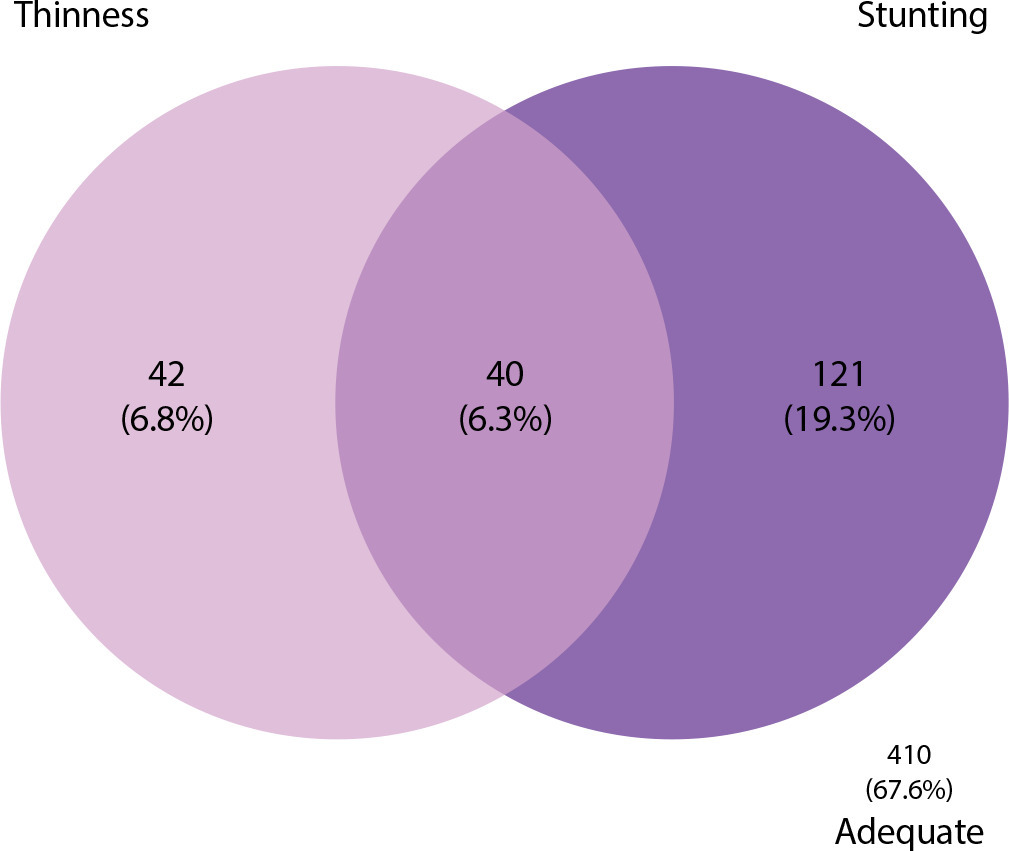
-
ORIGINAL ARTICLE11-29-2022
Outlining the therapeutic itineraries of children with disabilities in the professional health care subsystem
Revista Brasileira de Enfermagem. 2022;75(3):e20210169
Abstract
ORIGINAL ARTICLEOutlining the therapeutic itineraries of children with disabilities in the professional health care subsystem
Revista Brasileira de Enfermagem. 2022;75(3):e20210169
DOI 10.1590/0034-7167-2021-0169
Views0See moreABSTRACT
Objectives:
to identify the outlining of therapeutic itineraries of families of children with disabilities in the professional health care subsystem.
Methods:
qualitative research carried out in two specialized services in the state of Ceará, with 41 family members interviewed using the life path technique and reports submitted to descending hierarchical classification and similitude analysis, with the help of the IRaMuTeQ software and the theoretical framework of health care systems.
Results:
the classes described the families’ itineraries in five paths, related to faith, support structures, medical behaviors, professionals, and health services. The professional subsystem stood out as deficient in outlining the therapeutic itinerary for access to health care for children with disabilities, without promoting integration between services in the Care Network.
Final considerations:
the families’ therapeutic itineraries showed homogeneous discourse with themes related to the care of professionals and spiritual aspects.
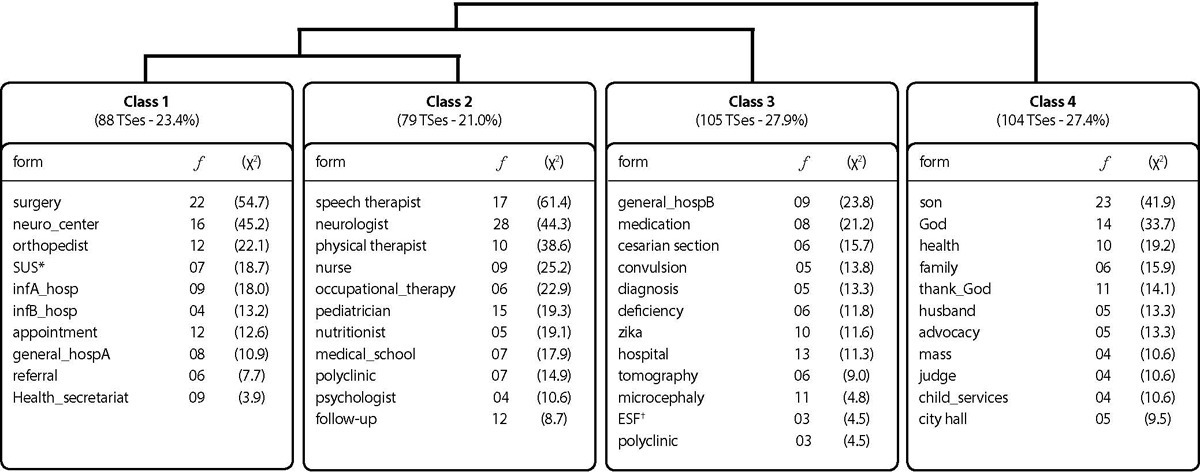
-
ORIGINAL ARTICLE11-29-2022
Ergonomics of anatomical bra models for breastfeeding: a contribution of nursing
Revista Brasileira de Enfermagem. 2022;75(3):e20210264
Abstract
ORIGINAL ARTICLEErgonomics of anatomical bra models for breastfeeding: a contribution of nursing
Revista Brasileira de Enfermagem. 2022;75(3):e20210264
DOI 10.1590/0034-7167-2021-0264
Views0See moreABSTRACT
Objectives:
to analyze the ergonomics of two models of breastfeeding bras.
Methods:
descriptive study carried out with 152 infants in a Brazilian university hospital. The prototypes were separated into two groups (A and B). To compare the two bra models, the Odds Ratio (OR) was used as a measure of the strength of the association. In subjective perceptions, the Modified Borg Scale, and the chi-square test of independence (χ2) were used. To compare the two prototypes, the Z test and logistic regression analysis were performed. A significance level of 5% was considered.
Results:
the bra in group B was more suitable for ergonomics of physical and psycho-aesthetic comfort than the bra in group A (p < 0.0001), according to the logistic regression tests.
Conclusions:
modeling B was ergonomically adequate, with usability and evaluation criteria centered on breastfeeding women.
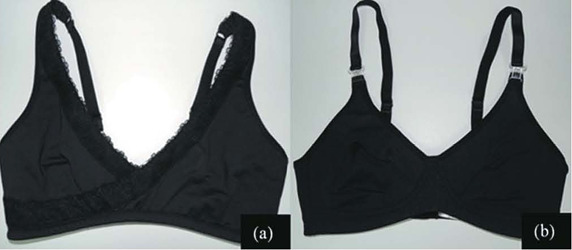
-
ORIGINAL ARTICLE11-29-2022
Knowledge of caregivers and factors associated with neuropsychomotor development in children
Revista Brasileira de Enfermagem. 2022;75(3):e20210402
Abstract
ORIGINAL ARTICLEKnowledge of caregivers and factors associated with neuropsychomotor development in children
Revista Brasileira de Enfermagem. 2022;75(3):e20210402
DOI 10.1590/0034-7167-2021-0402
Views0See moreABSTRACT
Objectives:
to analyze the knowledge of caregivers and the factors associated with neuropsychomotor development in children.
Methods:
a cross-sectional study, with a quantitative approach, was conducted with 220 child-caregiver binomials attended in the public health services of the municipality of Parnaíba, State of Piauí. The study used the “Denver Test II” and the “Inventory of Child Development Knowledge”.
Results:
the study classified 197 children with natural development and 23 with suspicious development. Caregivers with a higher level of knowledge about child development were associated with children with better development. The study considered caregiver knowledge, gestational age, and exclusive breastfeeding as protective factors for appropriate neuropsychomotor development when used the regression model.
Conclusions:
actions aimed at indicators that presented positive associations must be implemented to improve child development, such as educational activities to increase the level of knowledge of caregivers, improvement of prenatal monitoring, and encouragement of breastfeeding.
-
ORIGINAL ARTICLE11-29-2022
Ethics in nursing: categorization of legal processes
Revista Brasileira de Enfermagem. 2022;75(3):e20210099
Abstract
ORIGINAL ARTICLEEthics in nursing: categorization of legal processes
Revista Brasileira de Enfermagem. 2022;75(3):e20210099
DOI 10.1590/0034-7167-2021-0099
Views0See moreABSTRACT
Objectives:
to categorize factual elements of ethical-disciplinary nursing lawsuits in the state of Goiás.
Methods:
cross-sectional, retrospective study, based on secondary data obtained from ethical-disciplinary lawsuits filed at the Regional Nursing Council of Goiás (Coren-Goiás) between the years 2010 and 2019.
Results:
the highest number of lawsuits filed was in 2013 and 2014, with a greater frequency in the state capital. The majority came from the Nursing Ethics Committees and ex-officio complaints. The professional with most complaints was the nursing technician, aged between 31 and 40 years old, at the beginning of their career. The most common type of complaints referred to performing attributions that were not within the nursing competences.
Conclusions:
as a highlight are the contributions of this study to professional ethics in nursing and the clear need to consolidate these skills in nurses who are in training and in the continuous education for those already in the profession.
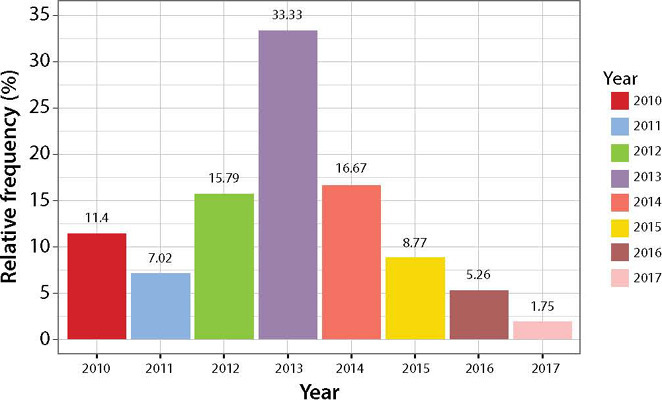
-
ORIGINAL ARTICLE11-29-2022
Exclusive breastfeeding and professionals from the family health strategy
Revista Brasileira de Enfermagem. 2022;75(3):e20200545
Abstract
ORIGINAL ARTICLEExclusive breastfeeding and professionals from the family health strategy
Revista Brasileira de Enfermagem. 2022;75(3):e20200545
DOI 10.1590/0034-7167-2020-0545
Views0See moreABSTRACT
Objectives:
to analyze the perception of health professionals about exclusive breastfeeding in Family Health Strategy units in the city of Macaé.
Methods:
qualitative study carried out in four units of the Family Health Strategy in the city of Macaé, Rio de Janeiro. Thirty health professionals were interviewed from March to May 2019. Textual contents were processed in the IRaMuTeQ® software by the Descending Hierarchical Classification.
Results:
professionals use different strategies for actions to promote, protect and support breastfeeding in prenatal consultations, but social and cultural determinants are important issues that interfere in this process, the involvement of the family being essential for the success of this practice.
Final Considerations:
health professionals, including nurses, need training and qualification to strengthen the support and social network of pregnant women and insert the family in the different strategies used to improve adherence to exclusive breastfeeding.

-
ORIGINAL ARTICLE11-29-2022
Specific health-related quality of life in Cerebrovascular accident survivors: associated factors
Revista Brasileira de Enfermagem. 2022;75(3):e20210407
Abstract
ORIGINAL ARTICLESpecific health-related quality of life in Cerebrovascular accident survivors: associated factors
Revista Brasileira de Enfermagem. 2022;75(3):e20210407
DOI 10.1590/0034-7167-2021-0407
Views0See moreABSTRACT
Objectives:
to identify factors associated with specific health-related quality of life in cerebrovascular accident, or stroke, survivors.
Methods:
cross-sectional study, carried out with 160 cerebrovascular accident survivors. Data were collected using the Barthel Index, Cerebrovascular Accident Specific Quality of Life Scale, and semi-structured instruments for sociodemographic and clinical data, analyzed by descriptive and inferential statistics.
Results:
health-related quality of life was associated with work activity (p=0.027), physical activity (p=0.007), functional capacity (p=0.001), presence of caregiver (<0.001), motor alteration (p = 0.001) and rehabilitation (p=0.003). The functionally dependent people were 14.61 times more likely to present low health-related quality of life, and those with motor impairment were 3.07 times more likely.
Conclusions:
it was evidenced that functional dependence and motor impairment increase the chance of low health-related quality of life in cerebrovascular accident survivors.
-
EXPERIENCE REPORT01-01-2018
Clinical and epidemiological teaching of dengue through simulated practice
Revista Brasileira de Enfermagem. 2018;71(2):451-456
Abstract
EXPERIENCE REPORTClinical and epidemiological teaching of dengue through simulated practice
Revista Brasileira de Enfermagem. 2018;71(2):451-456
DOI 10.1590/0034-7167-2016-0503
Views2See moreABSTRACT
Objective:
to describe the experience of clinical teaching on dengue and the practice of epidemiological surveillance using problematization methodology.
Method:
report of experience on educational activity with undergraduate nursing students, held in March 2016, at a public university in the city of São Paulo, conceived in four stages: dialogic lecture, active search of Aedes aegypti, case study and simulation of nursing consultation to individuals with dengue.
Results:
The activity allowed to retrieve previous knowledge about the disease, respond to exercises that addressed different clinical situations and epidemiological surveillance, including in situ evaluation of possible mosquito outbreaks, and discuss the need to expand prevention and health of the individual and the community, the impact of the media in the dissemination of cases and the coping difficulties experienced in the different levels of attention.
Conclusion:
the methodology adopted enabled qualified training of students to cope with dengue.

-
ORIGINAL ARTICLE07-18-2022
Beliefs, knowledge, actions of nursing techniques in breastfeeding in pain management in immunization
Revista Brasileira de Enfermagem. 2022;75(6):e20210546
Abstract
ORIGINAL ARTICLEBeliefs, knowledge, actions of nursing techniques in breastfeeding in pain management in immunization
Revista Brasileira de Enfermagem. 2022;75(6):e20210546
DOI 10.1590/0034-7167-2021-0546
Views1See moreABSTRACT
Objective:
Understand the beliefs, knowledge, and actions of nursing technicians on breastfeeding as a form of non-pharmacological intervention to relieve pain in newborns and infants during immunization.
Methods:
Qualitative study carried out through semi-structured interviews with nine nursing technicians from three Basic Health Units in a city in the state of São Paulo. The theoretical approach of the Belief Model and the methodological framework of Thematic Analysis supported this study.
Results:
Three themes originated: Beliefs, Knowledge, and Actions of nursing technicians.
Final considerations:
Despite knowledge about the benefits of breastfeeding as the most effective method for relieving pain in newborns and infants during vaccination, their restrictive beliefs overrode the evidence, leading them to act in ways that discourage or prevent the mother from breastfeed during vaccination. Formal training is recommended to align with current evidence-based practices.
-
REVIEW12-08-2023
Educational technologies for accident prevention due to falls in childhood: a scoping review
Revista Brasileira de Enfermagem. 2023;76:e20220807
Abstract
REVIEWEducational technologies for accident prevention due to falls in childhood: a scoping review
Revista Brasileira de Enfermagem. 2023;76:e20220807
DOI 10.1590/0034-7167-2022-0807
Views2See moreABSTRACT
Objectives:
to map evidence on educational technology use for accident prevention due to falls in childhood.
Methods:
a scoping review, carried out in October and November 2022, in the MEDLINE, Web of Science, BDENF and CINAHL databases and LILACS bibliographic index. There was no delimitation of language or time. Data were extracted and analyzed descriptively by two independent researchers. The research protocol was registered in the Open Science Framework.
Results:
twenty-six studies were selected. Booklets, pamphlets and leaflets were the most used technologies, presenting health services as the most frequent environment to develop research on fall prevention. The technologies developed were important outcomes: increased knowledge of children, family members, caregivers, health and education professionals.
Conclusions:
educational technology use makes it possible to increase knowledge, adopt safe practices and reduce falls.

-
REVIEW03-15-2024
Resources for health literacy among caregivers of prematurely born children: a scoping review
Revista Brasileira de Enfermagem. 2024;77(1):e20230062
Abstract
REVIEWResources for health literacy among caregivers of prematurely born children: a scoping review
Revista Brasileira de Enfermagem. 2024;77(1):e20230062
DOI 10.1590/0034-7167-2023-0062
Views1See moreABSTRACT
Objectives:
to map the available evidence on resources used to promote health literacy among caregivers of prematurely born children during outpatient follow-up.
Methods:
the Joanna Briggs Institute’s scope review protocol was utilized. The search encompassed six databases, incorporating studies from 2012 to 2022.
Results:
the three included publications revealed that the resources employed are: mobile applications, phone calls, individual counseling, videos, educational pamphlets, and group discussions. Implementing an education protocol during the transition home enhances scientifically grounded health promotion rates.
Conclusions:
there is limited literature addressing the health literacy of these caregivers. The nursing team plays a crucial role in health education and in developing resources applicable to these families.

-
ORIGINAL ARTICLE01-13-2024
Social representations of oncologic surgery for patients with cancer
Revista Brasileira de Enfermagem. 2024;77(6):e20230273
Abstract
ORIGINAL ARTICLESocial representations of oncologic surgery for patients with cancer
Revista Brasileira de Enfermagem. 2024;77(6):e20230273
DOI 10.1590/0034-7167-2023-0273
Views2See moreABSTRACT
Objectives:
to analyze the social representations of patients with cancer regarding oncologic surgery.
Methods:
a qualitative study based on Social Representation Theory was conducted with 126 participants between October 2021 and May 2022 in a public hospital in Rio de Janeiro. A characterization questionnaire, free evocations of the inducing term “surgery”, and semi-structured interviews with 60 participants were applied. Data were analyzed using Microsoft Excel® and IRaMuTeQ.
Results:
the central core of the representation is composed of fear, cure, hope, and removing the disease. The analysis of interviews resulted in six classes that highlight the social changes caused by treatment as well as the need for a support network to cope with the surgical process.
Final Considerations:
the representations reflect fear and hope towards the procedure and the desire to remove the disease, thus translating the cure through surgery.

-
ORIGINAL ARTICLE01-13-2024
Nurses’ perspectives on the use of telemonitoring in the management of people with diabetes and hypertension
Revista Brasileira de Enfermagem. 2024;77(6):e20230481
Abstract
ORIGINAL ARTICLENurses’ perspectives on the use of telemonitoring in the management of people with diabetes and hypertension
Revista Brasileira de Enfermagem. 2024;77(6):e20230481
DOI 10.1590/0034-7167-2023-0481
Views3See moreABSTRACT
Objectives:
to understand the perspective of nurses on the use of telemonitoring in the management of people with type 2 diabetes mellitus and arterial hypertension in primary care.
Methods:
this qualitative research involved sixteen nurses from eight municipalities in Paraná. Data were collected between November 2022 and January 2023 through inperson or remote interviews, which were audio-recorded and subjected to content analysis.
Results:
according to the nurses, telemonitoring enhances users’ knowledge about these conditions, communication and connection with the team, and productivity. However, the lack of electronic resources and equipment, high staff turnover, low user adherence, and the limited availability of professional time present significant challenges.
Final Considerations:
the effective implementation and operation of telemonitoring in the management of people with diabetes and hypertension involve both potential benefits and barriers. It is essential to have the availability of human and technological resources, managerial support, and the commitment of professionals and users.
-
ERRATUM01-13-2024
ERRATUM
Revista Brasileira de Enfermagem. 2024;77(6):e2024n6e08
Abstract
ERRATUMERRATUM
Revista Brasileira de Enfermagem. 2024;77(6):e2024n6e08
DOI 10.1590/0034-7167.20247706e08
Views2In the article “Brazilian nursing specific situation, middle and micro-range theories: a bibliometric study”, with DOI number: , published in Revista Brasileira de Enfermagem, 2024;77(4):e20230520, Chart 1:Where it read:[…]See more -
ORIGINAL ARTICLE09-29-2022
Palliative care production for health professionals in the context of home care
Revista Brasileira de Enfermagem. 2022;75(1):e20210030
Abstract
ORIGINAL ARTICLEPalliative care production for health professionals in the context of home care
Revista Brasileira de Enfermagem. 2022;75(1):e20210030
DOI 10.1590/0034-7167-2021-0030
Views1See moreABSTRACT
Objectives:
to analyze palliative care production developed by health professionals to home care patients.
Methods:
this is an exploratory study, with a qualitative approach, using the transpersonal care theoretical framework. Thirteen interviews were conducted with health professionals and 18 observations were conducted on different cases. Content analysis was performed using MAXQDA©.
Results:
actions performed: maintenance and follow-up measures to people eligible for palliative care, in acts of dialogue and “listening” to caregivers and users, conducting guidelines for the care and self-care process, performing technical procedures, delivery of materials, referrals and medical prescriptions to users.
Final Considerations:
it is perceived the need for advances in the implementation of government policies in Brazil that insert palliative care into the Health Care Network through educational, managerial and care actions that ensure human dignity, thus allowing the development of these and other palliative care interventions.
-
ORIGINAL ARTICLE07-08-2020
Spirituality and religiousity in the experience of suffering, guilt, and death of the elderly with cancer
Revista Brasileira de Enfermagem. 2020;73:e20190034
Abstract
ORIGINAL ARTICLESpirituality and religiousity in the experience of suffering, guilt, and death of the elderly with cancer
Revista Brasileira de Enfermagem. 2020;73:e20190034
DOI 10.1590/0034-7167-2019-0034
Views0See moreABSTRACT
Objective:
to understand spirituality and religiosity in the experience of suffering, guilt, and death of the elderly with cancer.
Method:
qualitative research based on Viktor Frankl’s Existential Analysis. Twenty phenomenological interviews were conducted with people over 60 years old undergoing chemotherapy treatment at an oncology unit of a hospital in the city of Salvador, Bahia State, Brazil, between August and October 2018.
Results:
the following categories emerged: Experiences spirituality and religiosity in the face of the tragic triad and existential emptiness; Uses spirituality/religiosity as resilience strategies. After apprehension of ontic aspects, it was possible the ontological understanding of spirituality and religiosity in the face of suffering, guilt, and death experienced in the elderly with cancer’s daily life.
Final considerations:
spirituality and religiosity were understood as coping strategies used in the unstable experience of the elderly with cancer, providing comfort and resilience.
-
ORIGINAL ARTICLE09-16-2019
Depression, self-concept, future expectations and hope of people with HIV
Revista Brasileira de Enfermagem. 2019;72(5):1288-1294
Abstract
ORIGINAL ARTICLEDepression, self-concept, future expectations and hope of people with HIV
Revista Brasileira de Enfermagem. 2019;72(5):1288-1294
DOI 10.1590/0034-7167-2018-0730
Views0See moreABSTRACT
Objective:
To analyze conditions of depression, self-concept, future expectations and hope in people with HIV/AIDS.
Method:
Cross-sectional survey of 108 individuals living with HIV/AIDS, carried out in a reference hospital for the treatment of infectious diseases in Northeast Brazil. The following instruments were employed: sociodemographic data, and questionnaires for ascertaining participants’ emotions, including scales for self-concept, hope, depression (HAMD-D), and future expectations. Descriptive statistics using the following tests were performed: Mann–Whitney, Kruskal–Wallis, chi-square, and t-test—considered significant when p ≤ 0.05.
Results:
31.5% presented mild depression and 21.3% presented moderate depression; 63% reported difficulty in obtaining decent employment; 52.8% considered life a failure; 52.8% felt worthless. Fear, guilt and loneliness influenced self-concept (p ≤ 0.05). Loneliness influenced hope (p ≤ 0.05).
Conclusion:
It is necessary to raise the attention of nursing professionals and healthcare managers to the importance of providing health services that consider the mental health of people with HIV/AIDS, contributing to treatment adherence and well-being.
-
ORIGINAL ARTICLE10-05-2020
Factors associated with the performance of episiotomy
Revista Brasileira de Enfermagem. 2020;73:e20190899
Abstract
ORIGINAL ARTICLEFactors associated with the performance of episiotomy
Revista Brasileira de Enfermagem. 2020;73:e20190899
DOI 10.1590/0034-7167-2019-0899
Views0See moreABSTRACT
Objective:
To analyze the factors associated with the performance of episiotomy.
Methods:
Cross-sectional study, developed with data from the research “Born in Belo Horizonte: Labor and birth survey, “conducted with 577 women who had their children via vaginal birth. In order to verify the magnitude of the association between episiotomy and its possible determinants, logistic regression models were constructed to estimate the odds ratio.
Results:
Episiotomy was performed in 26.34% of women, and 59.21% knew they had been subjected to it. We observed that younger women, primiparous women, women assisted by a professional other than the obstetric nurse and women who had their babies in a private hospital have an increased chance of being submitted to this procedure.
Conclusion:
Considering the rates of episiotomy, this study highlights the need for the absolute contraindication to indiscriminate performing it.
-
ORIGINAL ARTICLE12-13-2019
Obstetric Nursing in best practices of labor and delivery care
Revista Brasileira de Enfermagem. 2019;72:235-242
Abstract
ORIGINAL ARTICLEObstetric Nursing in best practices of labor and delivery care
Revista Brasileira de Enfermagem. 2019;72:235-242
DOI 10.1590/0034-7167-2018-0561
Views0See moreABSTRACT
Objective:
to evaluate the association of Obstetric Nursing in the best practices of delivery and birth care in maternity hospitals.
Method:
a cross-sectional study, with 666 women selected for delivery. Parturition obstetric practices performed by professionals were categorized into: clearly useful practices that should be encouraged, practices that are clearly harmful or ineffective and that should be eliminated and practices used inappropriately at the time of parturition.
Results:
clearly useful practices were used in greater proportions in the hospitals that had Obstetric Nursing working, while clearly harmful practices and those used inappropriately were practiced in smaller proportions in hospitals that had Obstetric Nursing, both with statistical difference.
Conclusion:
institutions with Obstetric Nursing adopt better practices of delivery and birth care, based on scientific evidence, when compared to those that do not act.
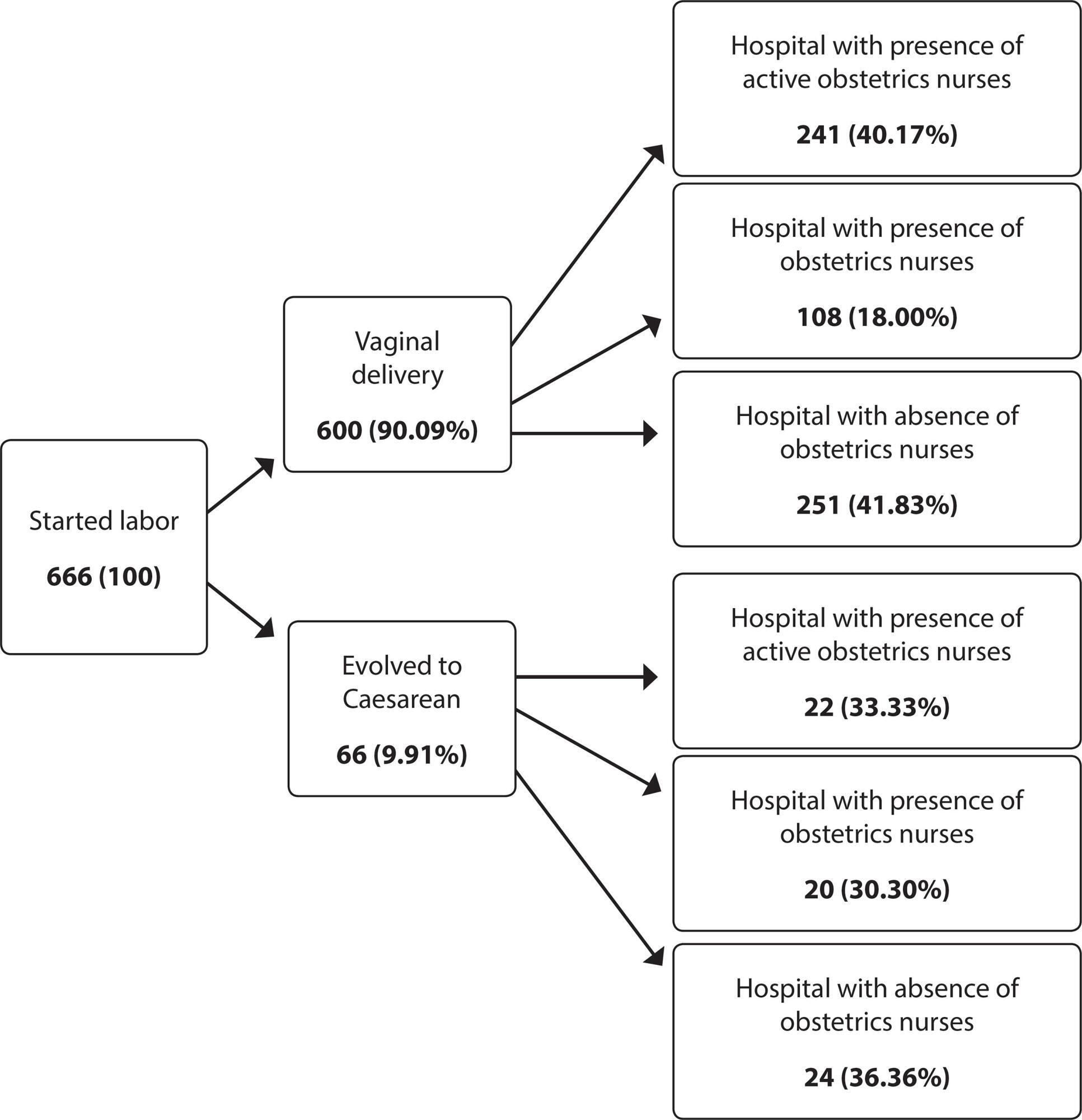
-
ORIGINAL ARTICLE09-16-2019
Temporal trend of leprosy in a region of high endemicity in the Brazilian Northeast
Revista Brasileira de Enfermagem. 2019;72(5):1356-1362
Abstract
ORIGINAL ARTICLETemporal trend of leprosy in a region of high endemicity in the Brazilian Northeast
Revista Brasileira de Enfermagem. 2019;72(5):1356-1362
DOI 10.1590/0034-7167-2018-0682
Views0See moreABSTRACT
Objective:
to analyze the temporal trend and epidemiological patterns of leprosy indicators in Sobral, a municipality countryside of the state of Ceará, from 2001 to 2016.
Method:
a time series study based on data from the Department of Informatics of the Unified Health System. The time trend analysis was performed using the join point regression model.
Results:
There were 2,220 new cases of leprosy in Sobral from 2001 to 2016. Of these, 158 (7.2%) in children younger than 15 years of age, the proportion of new male cases was 52.8% (1,162), cases with grade 2 were 7.0% (156), and proportion of cases diagnosed by contact examination 5.7% (126).
Final considerations:
leprosy remains hyperendemic in adults and children, demonstrating the character of neglected disease. Analysis of the temporal trend allowed to verify that the instability in the detection coefficients, reflect operational problems in the organization of the services
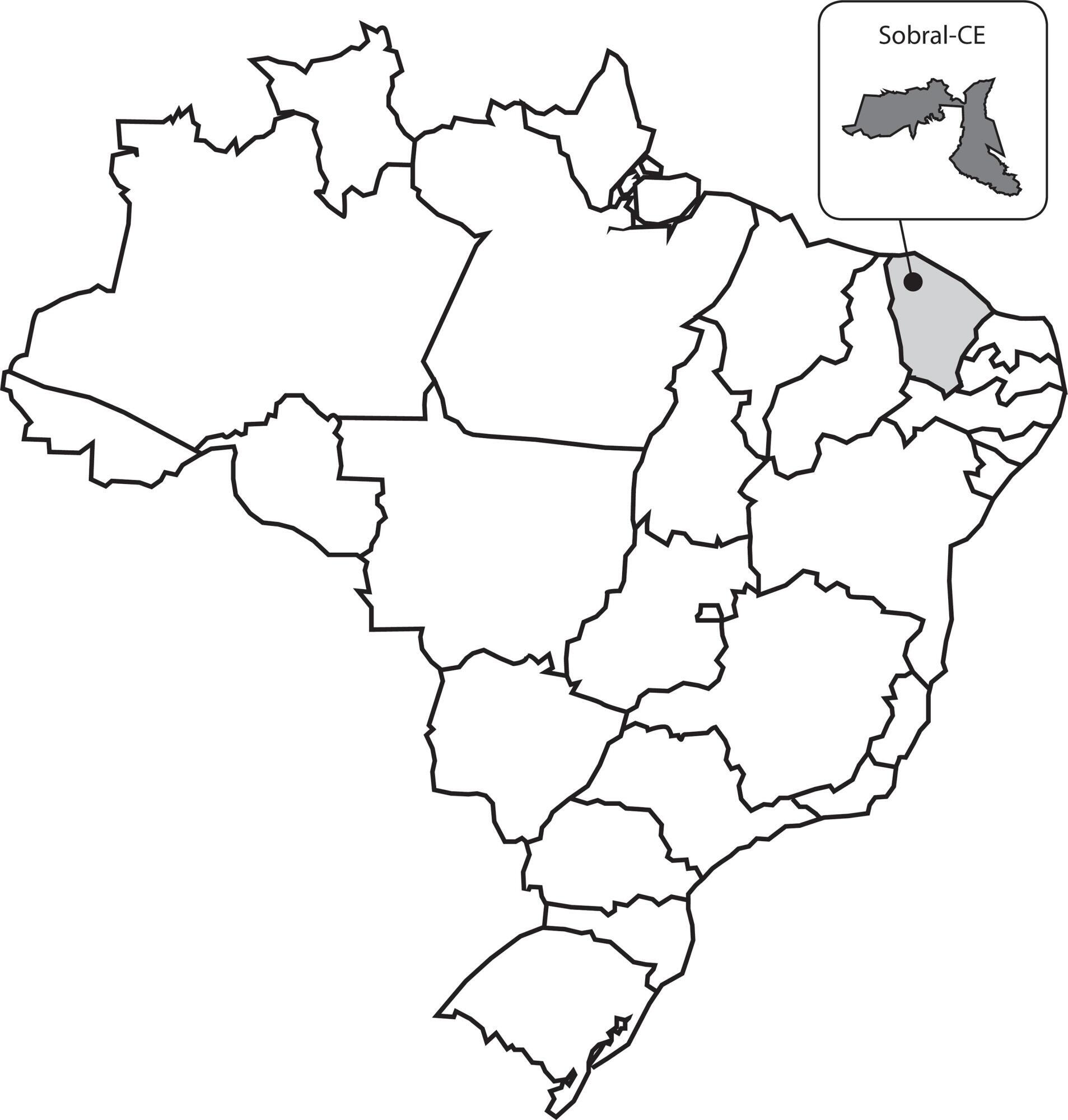
-
REVIEW08-20-2021
Assessment of patient safety culture in Brazilian hospitals through HSOPSC: a scoping review
Revista Brasileira de Enfermagem. 2021;74(6):e20201315
Abstract
REVIEWAssessment of patient safety culture in Brazilian hospitals through HSOPSC: a scoping review
Revista Brasileira de Enfermagem. 2021;74(6):e20201315
DOI 10.1590/0034-7167-2020-1315
Views0See moreABSTRACT
Objectives:
to describe, from literature, the characteristics of patient safety culture in Brazilian hospitals that applied the Hospital Survey on Patient Safety Culture.
Methods:
this is a scoping review. A search was performed in the databases LILACS, PubMed, SciELO, CINAHL, Web of Science, Scopus and in the CAPES Dissertations and Theses Database in September and October 2020.
Results:
thirty-six studies were identified. Nine studies identified strengthened areas such as: “teamwork within the units”, “expectations of supervisor/boss and actions promoting safety”, “organizational learning”, “support of hospital management for patient safety” and “frequency of report of events”. As a critical area, the dimension “non-punitive response to error” was evidenced in 30 of 36 studies.
Conclusions:
the identification of areas of strength and critical areas of safety culture is relevant to encourage improvement of patient safety problems in an institution.
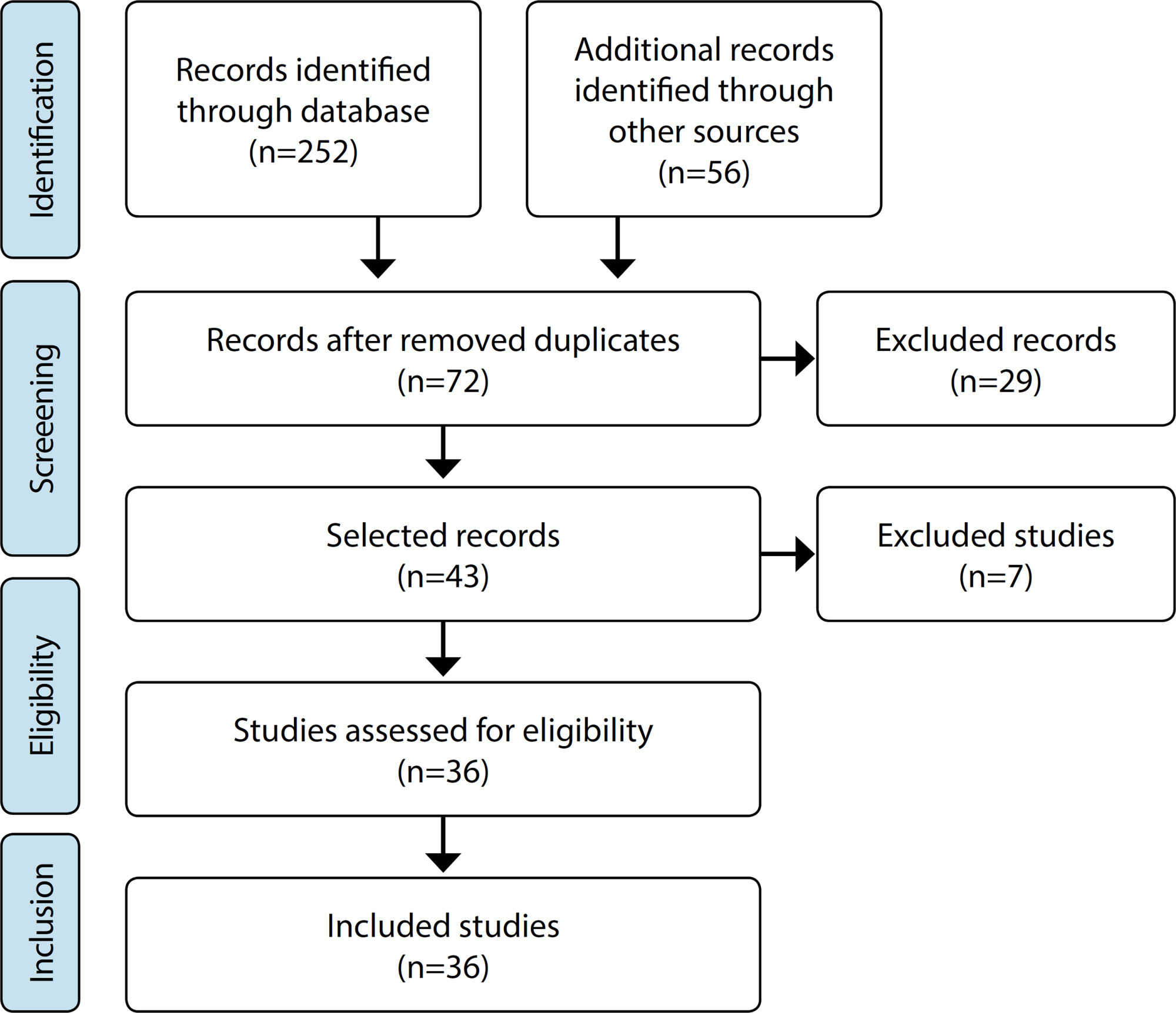
-
ORIGINAL ARTICLE03-07-2022
Adaptation and validation of the Advanced Practice Nursing Competency Assessment Instrument
Revista Brasileira de Enfermagem. 2022;75(5):e20210582
Abstract
ORIGINAL ARTICLEAdaptation and validation of the Advanced Practice Nursing Competency Assessment Instrument
Revista Brasileira de Enfermagem. 2022;75(5):e20210582
DOI 10.1590/0034-7167-2021-0582
Views0See moreABSTRACT
Objective:
To adapt and validate the content of the Advanced Practice Nursing Competency Assessment Instrument (APNCAI) to Brazilian culture.
Methods:
This is a methodological study that followed the stages of translation, synthesis, back translation, evaluation by a committee of five specialists, pre-test with 31 nurses, and evaluation by the author of the original instrument. The Content Validity Index (minimum 0.90) and the modified Kappa (minimum 0.74) were calculated to evaluate the content.
Result:
In the first round of content evaluation, 18 items had to be altered because they did not reach the minimum values established. Three items have not reached a consensus in the second round and had to be sent to the author of the original version. In the pre-test, 13 items were returned to the specialists because they suffered content changes.
Conclusion:
The Advanced Practice Nursing Competency Assessment Instrument (APNCAI) – Brazilian version was cross-culturally adapted, and its content was validated.
-
ORIGINAL ARTICLE09-21-2020
Anxiety and depression in informal caregivers of dependent elderly people: an analytical study
Revista Brasileira de Enfermagem. 2020;73:e20190851
Abstract
ORIGINAL ARTICLEAnxiety and depression in informal caregivers of dependent elderly people: an analytical study
Revista Brasileira de Enfermagem. 2020;73:e20190851
DOI 10.1590/0034-7167-2019-0851
Views0See moreABSTRACT
Objective:
To analyze the symptoms of anxiety and depression in informal caregivers of dependent elderly at home.
Methods:
Analytical, cross-sectional study conducted in the city of Teresina (PI), with informal caregivers of dependent elderly people. Data collection took place from November 2017 to February 2018, using a characterization form for the dependent elderly and their caregiver, Beck’s Anxiety Inventory (BAI) and Beck’s Depression Inventory (BDI). The forward linear regression model was used to identify the predictive variables of anxiety and depression.
Results:
It was found that 18.4% of caregivers had symptoms of depression; and 14%, moderate to severe anxiety. There was a correlation between anxiety and depression (p = 0.000).
Conclusion:
The findings of this study make it possible to assess anxiety and depression in caregivers of dependent elderly people, making it possible, through these parameters, to view the profile and care demands of this population.
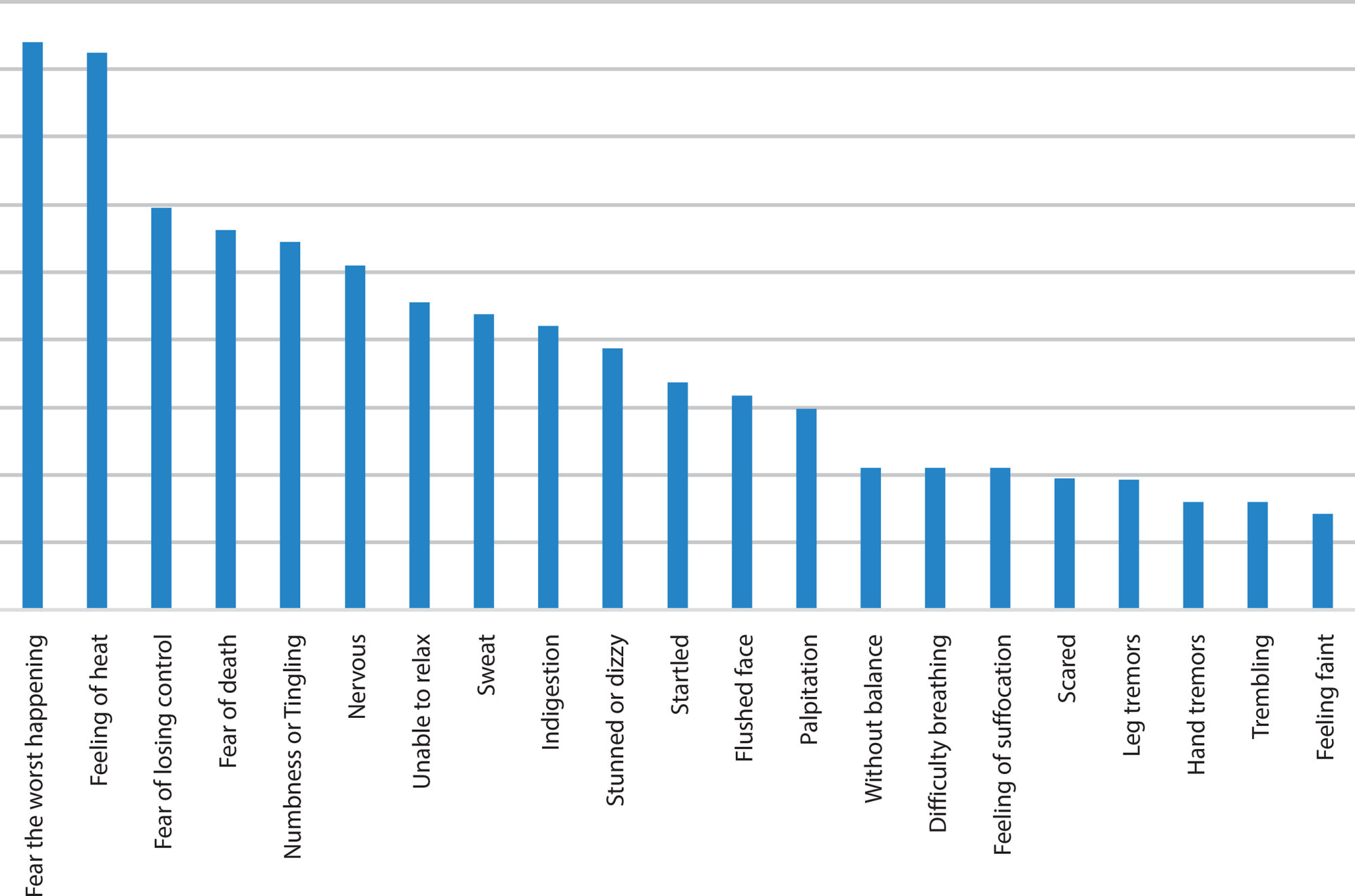
Search
Search in:
Nuvem de Tags
Adolescente (85) Atenção Primária à Saúde (239) COVID-19 (91) Criança (91) Cuidados de Enfermagem (269) Educação em Enfermagem (151) Educação em Saúde (139) Enfermagem (930) Enfermagem Pediátrica (86) Estudantes de Enfermagem (77) Estudos de Validação (131) Família (87) Idoso (208) Promoção da Saúde (99) Qualidade de Vida (104) Saúde do Trabalhador (86) Saúde Mental (145) Saúde Pública (82) Segurança do Paciente (150) Tecnologia Educacional (100)



